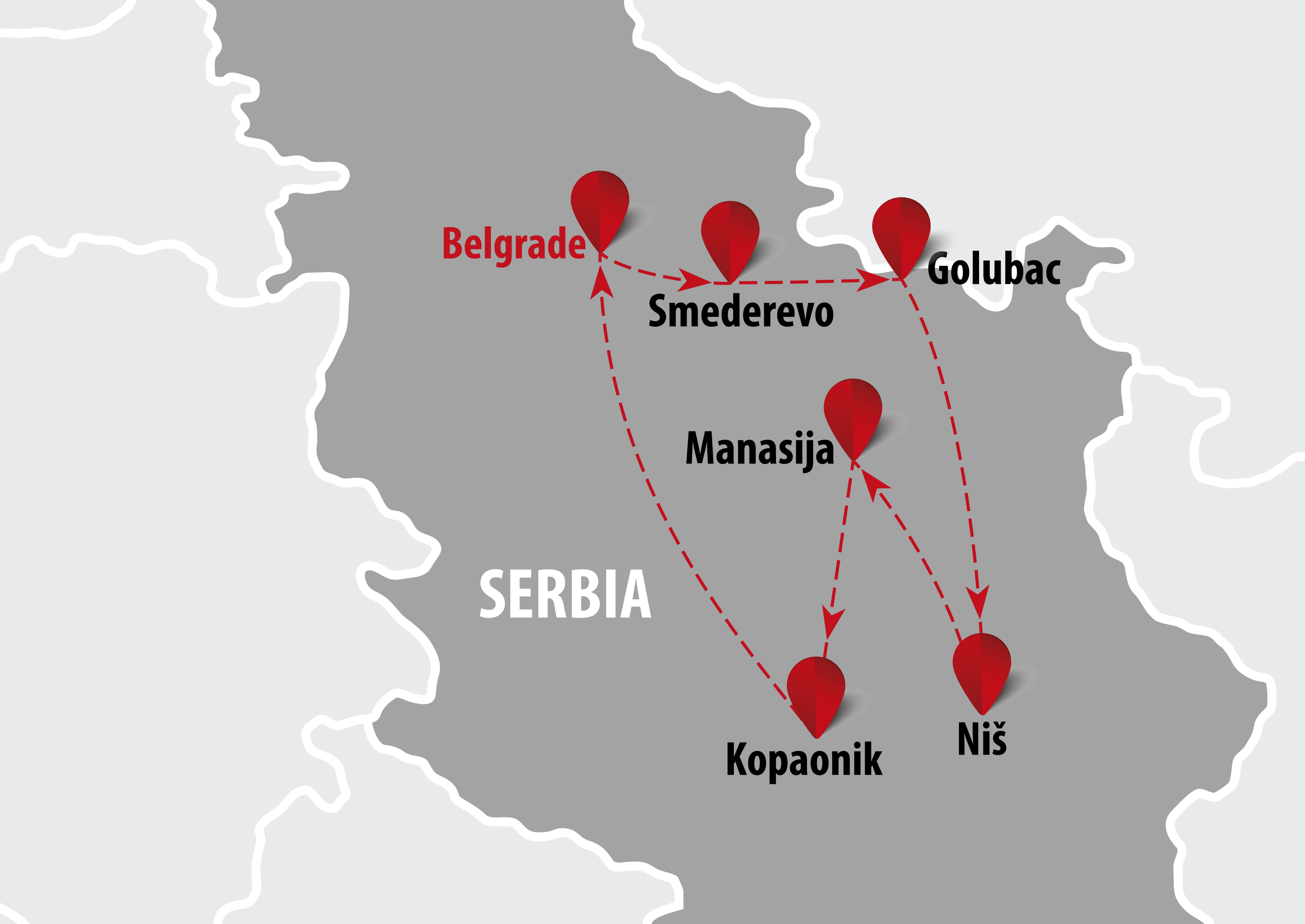
Days


Days
DAY 1. – Belgrade
Arrival in Belgrade. Meet & Greet at the Airport. Sightseeing of the Belgrade Fortress, visit the Roman Well built in the 18th century and the Big Gun Powder Warehouse from the 18th century. Transfer to the hotel and check-in. Overnight.
DAY 2 – Central Serbia
Start the day with the visit to Vinca Archeological site located 11km from Belgrade and dated from 6000 years ago. It is the largest and the most important researched Neolith site in Europe and the first settlement of a European civilization. The tour continues to Smederevo Fortress, the largest lowland fortress in Europe. Lunch in Smederevo followed by a visit to Viminacium Archaeological site where we will visit the Emperor Hostelian’s mausoleum, temples, thermal baths, the north gate of the Military camp, an aqueduct and recently discovered Roman Pantheon and Amphitheater. Transfer to Belgrade and overnight at the hotel.
First World War, the church was renovated in 1925. St. Petka`s Church – The construction of the building started in 1935. in place of an old chapel, above a spring which is considered to have miraculous powers. It was completed and revived on the day of St. Petka-Paraskeva, Visit the Museum of Serbia Orthodox Church and a wine cellar in the cave, built by Serbs in the 18th century. Lunch in Kaludjerica with Blagoje Ninkovic, manufacturer of icons. Return to the accommodation for a short rest. Dinner in Skadarlija at 2 Jelena Restaurant – Skadarlija is a vintage street, an urban neighborhood and former municipality of Belgrade, the capital of Serbia. Overnight at the Rakovica Monastery
DAY 3. – Eastern Serbia
Tour day starts visiting the Golubac Fortress, one of the most beautiful medieval fortresses, where the Danube is widest -6,5 km, and that’s just before the Djerdap Gorge, the largest gorge in Europe where the Danube is deepest – 92 meters. Visit the Lepenski Vir Archaeological site, the oldest urban settlement in Europe dated 7000 years B.C. Lepenski Vir is a spectacular archaeological site in Serbia which is the Cradle of Europe, it was discovered and explored by Professor Dragoslav Srejovic in the 1960s as part of the project of rescue excavations undertaken due to the creation of an artificial lake upstream of the exit of the Danube from the Iron Gates gorges. The Iron Gates represent an exceptional natural environment with a special microclimate. Even the precipitation rate, mild transition between seasons, relative atmospheric humidity, absence of strong air currents or sharp temperature changes, lime-based ground preserving warmth, and secure food sources enabled the Mesolithic people of Lepenski Vir to create an imposing culture whose rich and original contents can hardly be paralleled in any other of the same period, or even later. Djerdap Gorge with its Iron Gate is a center of Đerdap National Park which is a candidate to the UNESCO World Heritage list. Lepenski Vir is best known for its perfectly carved stone figures of humans with large eyes and fish-like mouths, probably idols of hunters and fishermen whose lives depended on mighty Danube River that are the earliest examples of the stone sculptures and the first monumental art created after the Ice Age. Visit the Tabula Traiana, which is the Roman memorial plaque stone with the carved Latin inscription situated just above the Djerdap Canyon and the Iron Gate dedicated to the Roman Emperor Trajan. Overnight in the hotel at Lepenski Vir.
DAY 4. – Eastern Serbia
Visit the Felix Romuliana ruins of the luxurious Imperial Roman Palace lie in the village of Gamzigrad, south of the Danube. Felix Romuliana was built by the Roman Emperor Gaius Galerius Valerius Maximianus between 297 and 311 A.D. to glorify his victory over Persians that brought him admiration and glory. The late Roman fortified palace compound of Felix Romuliana containing luxurious structures protected by massive walls having hexagonal turrets in order to resist the barbarian attacks. Felix Romuliana memorial complex was inscribed as a unique testimony of Roman building tradition of the period of the Second Tetrarchy and covers the surface of 6,5 hectares. Since 2007, the fortified palace of Felix Romuliana is part of the UNESCO Cultural Heritage and thus attracts more and more visitors as well as historians and archaeologists from all over the world. Visit the Sarkamen Archeological site dated from the 3rd century and built by the Roman emperor Maksimin Daja, it represents one of the 4 Roman palaces outside of the Roman empire. Overnight in ethnic hotel in the Rtanj mountain.
DAY 5. – Southern Serbia
The day starts with a visit to the city of Nis, the birthplace of the Roman Emperor Constantine the Great and the location of the Iustiniana Prima Archeological site – the Emperors town is one of the most significant Early-Byzantine towns in the interior of the Balkans dated from the 6th century; where was discovered a military and civil architecture, an urban spatial planning, a construction of houses and remarkable remains of the material culture, testify in the achievements of the early Byzantine civilization, founded on the Graeco-Roman tradition. Significance of Emperors town is known by the fact that the settlement was Episcopal seat and military and administrative center of the Iustiniana Prima Illyric Province, and the seat of the Archbishopric of the North Illyricum, mostly inhabited by the Slavs-Serbs since the middle of the 6th century. As per Procopius’s writings in 545 Emperor Justinian I had built Justiniana Prima to become a city “worthy to be the metropolis of the whole region” which have become the capital of Dardania. In addition, Iustiniana Prima has been chosen as the see of Illyricum, featuring the numerous churches, lodgings for magistrates, the great stoats, the fine market-places, the fountains, the streets, the baths, the shops. Archeological site is divided to 3 parts: lower, middle and upper parts. Follows visit the Mediana archeological site. Mediana archaeological site was luxurious Imperial Roman Residence and antique historical site located in the suburbs of Naissus(todays Nis city), built on the Via Militaris road that in antiquity connected Singidunum /nowadays Belgrade/ with Serdica /nowadays Sofia/ and Constantinople /nowadays Istanbul/ at the beginning of the 3rd century A.D. Covers 40 hectares in the vicinity of the Nisava River and thermal springs to witness of imperial Naissus wealth and glory. The remains of the Imperial palace, together with peristyle were discovered in the Mediana archaeological site. Follows visit to archeological site Plocnik, which is the Neolithic archaeological site, part of the Vinca culture. Archaeological site spreads on 120 hectares that included several parts between courses of three rivers. The unnamed tribe who lived between 5400 and 4700 BC in the 120-hectare site at what is now Plocnik site, knew about trade, handcrafts, art and metallurgy what testify on the metropolis with a great degree of sophistication and a taste for art and fashion. They were engaged in agriculture and stone was the main material for making their tools. They pursued beauty and produced 60 different forms of wonderful pottery and figurines, not only to represent deities, but also out of pure enjoyment. Within the archaeological complex of Plocnik numerous wonderful clay pottery and lots of stone and copper objects were found. Tour continues to Vrnjacka spa. Free time and overnight.
DAY 6. – Central and Eastern Serbia
Visit to some of the monasteries in the Morava river region. Manasija monastery is one of the last monuments to Serbian mediaeval culture. The church was raised by Despot Stefan Lazarević, son of Prince Lazar Hrebeljanović. The construction of the church, an extravagant fortification and the large refectory took from 1406 to 1418. The impressive walls with 11 towers, surrounded by a trench, would at that time have been a modern system for the defense of the monastery. The most dominant and most imposing tower – the keep – is known as Despotova Kula – Despot’s Tower. The castle was entered via a large gate on the western side. The Church of the Holy Trinity is considered a prime example of Morava architecture. A particular rarity in Serbian mediaeval architecture is the mosaic floor. The frescoes in Manasija, together with those in Kalenić, are the most beautiful of the Morava properties and are considered among the best in old Serbian art, in general. Besides the monumental depictions of warriors in the choir transept, especially beautiful are the prophets pictured in the dome, as well as the idealized depiction of Despot Stefan Lazarević presenting a model of the church to the Holy Trinity. Besides monastery churches and fortifications, Manasija partially preserves the remains of the old refectory and library. The library housed a scriptorium in which numerous books were copied for church use. The so-called “Resava orthography” was greatly valued and was to influence later scribes for some time to come.
Ravanica monastery was built during the period between 1375 and 1377, and its frescoes were painted in the years preceding the famous Battle of Kosovo. It was built by one of the most beloved rulers of Serbia, emperor Lazar, father of Despot Stefan who built Manasija monastery. Due to its architectural and artistic features, the Ravanica church can be called the birthplace of the new artistic movement called the Morava school. The church is original in its architectural style, which is a blend of the Mount Athos tradition of the trefoil base and the cross-in-square five-domed model which became a standard in the time of King Milutin.
Kalenic monastery was built at the end of 15th century. It is considered as one of the most beautiful examples of Morava architecture and Byzantine construction. The church is very picturesque from the outside due to the beautifully laid blocks of white stone and red brick. The exceptional painting, with its refined coloring and pensive figures of saints, is considered one of the finest artistic works in the entire Byzantine world among those dating from the first quarter of the 15th century. Especially striking are the composition Wedding at Cana, and the depictions of holy warriors and saints set into medallions. Return to Vrnjacka spa, free time for spa activities and overnight.
Visit the beautiful Lisine waterfall, a protected monument of nature, with a special lunch in a restaurant across the waterfall. Follows visit to Resava cave, one of the most beautiful and the biggest caves in Serbia with its phenomenal cave jewelry. It is old around 80 million years. For now, researched are 3km of the cave, but 800m are prepared for visitors. It has the status of a protected monument of nature.
DAY 7. – Central and Southern Serbia
Visit the National Park of Kopaonik and the Celestial Chairs Archeological site. The site is dated from the Late Antiquity – 3rd and 4th centuries, and the early Christian period – end of the 5th and 6th centuries, located at an altitude of 1800 meters in the Kopaonik Mountain.
Kopaonik – known as the Silver mountain and named by Roman, Venetian, and Turkish sources, is the biggest mountain massif in Serbia, spread from northwest to southeast of Serbia along 95 km, and 40 km wide in its central ridge. Part of the Kopaonik Mountain surface is a protected region proclaimed Kopaonik National Park, comprising abundance of intact nature and beautiful landscape, being the biggest and most important ski center in Serbia. Kopaonik Mountain is the place where you can find examples of endemic flora such as Pancic’s spruce, Pancic’s watercress, and Kopaonik violet. There are also a lot of animal species like the gray falcon, fallow deer, wild cat and eagle.
DAY 8.
Departure to Belgrade. Transfer to the airport.
Prices on request, we have special offers for you!
Customize your package.
What is included:

 “Sultan” Package Serbia | 8 days
“Sultan” Package Serbia | 8 days 